Isotope Geochemistry of the Heihaibei Gold Deposit within the Kunlun River Area in the Eastern Kunlun Orogen in Northwest China and Its Metallogenic Implications
Abstract
:1. Introduction
2. Geological Background and Ore Deposit Geology
2.1. Geological Background
2.2. Ore Deposit Geology
3. Sampling and Analytical Methods
3.1. Sampling
3.2. Oxygen and Hydrogen Isotope Analysis
3.3. Sulfur Isotope Analysis
3.4. Lead Isotope Analysis
4. Results
4.1. Oxygen and Hydrogen Isotope Results
4.2. Sulfur Isotope Results
4.3. Lead Isotope Results
5. Discussion
5.1. Origins of the Ore-Forming Fluid
5.2. Sulfur Sources
5.3. Lead Sources
5.4. Genetic Type and Possible Metallogenic Model
6. Conclusions
Supplementary Materials
Author Contributions
Funding
Institutional Review Board Statement
Informed Consent Statement
Data Availability Statement
Acknowledgments
Conflicts of Interest
References
- Bian, Q.T.; Li, D.H.; Pospelov, I.; Yin, L.M.; Li, H.S.; Zhao, D.S.; Chang, C.F.; Luo, X.Q.; Gao, S.L.; Astrakhantsev, O.; et al. Age, geochemistry and tectonic setting of Buqingshan ophiolites, North Qinghai–Tibet Plateau, China. J. Asian Earth Sci. 2004, 23, 577–596. [Google Scholar] [CrossRef]
- Xu, Z.Q.; Yang, J.S.; Li, H.B.; Zhang, J.X.; Wu, C.L. Terrane Amalgamation, Collision and Uplift in the Qinghai–Tibet Plateau; Geological Publishing House: Beijing, China, 2007; p. 458. [Google Scholar]
- Jiang, C.F.; Yang, J.S.; Feng, B.G.; Zhu, Z.X.; Zhao, M.; Chai, Y.C.; Shi, X.D.; Wang, H.D. Opening Closing Tectonics of Kunlun Shan; Geological Publishing House: Beijing, China, 1992; p. 217. [Google Scholar]
- Zhou, X.; Pan, T.; Ding, Q.-F.; Cheng, L.; Song, K.; Liu, F.; Gao, Y. Isotope Geochemistry of the Shenshuitan Gold Deposit within the Wulonggou Gold Field in the Eastern Kunlun Orogen, Northwest China: Implications for Metallogeny. Minerals 2022, 12, 339. [Google Scholar] [CrossRef]
- Li, Z.M.; Xue, C.J.; Wang, X.H.; Tang, H.; Tu, Q.J.; Teng, J.X.; Li, R.S. Features of regional mineralization and analysis of the exploration development in the Eastern Kunlun Mountains. Geol. Rev. 2007, 53, 708–718, (In Chinese with English abstract). [Google Scholar]
- Du, Y.L.; Jia, Q.Z.; Han, S.F. Mesozoic tectono-magmatic-mineralization and copper-gold polymetallic ore prospecting research in East Kunlun Metallogenic Belt in Qinghai. Northwestern Geol. 2012, 45, 69–75, (In Chinese with English abstract). [Google Scholar] [CrossRef]
- Liu, F. Research on the Geological, Geochemical Characteristics and Genesis of Shenshuitan Gold Deposit in the Wulonggou Ore Concentration District in the Eastern Kunlun Orogenic Belt, Qinghai Province. Master’s Thesis, Jilin University, Changchun, China, 2017. [Google Scholar]
- Zhang, J.Y.; Ma, C.Q.; Li, J.W.; Pan, Y.M. A possible genetic relationship between orogenic gold mineralization and post-collisional magmatism in the eastern Kunlun Orogen, western China. Ore Geol. Rev. 2017, 81, 342–357. [Google Scholar] [CrossRef]
- Zhang, Y.T. Research on Metallogenesis of Gold Deposits in the Wulongou Ore Concentration Area, Central Segment of the East Kunlun Mountains, Qinghai Province. Ph.D. Thesis, Jilin University, Changchun, China, 2018. [Google Scholar]
- Song, K. Research on the Metallogenic Geological Background and Genesis of Huanglonggou Ore Block in Shenshuitan Gold Deposit in the Wulonggou Ore Concentration Area in the Eastern Kunlun Orogenic Belt, Qinghai Province. Master’s Thesis, Jilin University, Changchun, China, 2019. [Google Scholar]
- Tian, C.S. Research on Gold Mineralization and Metallogenic Prognosis of Wulonggou Goldfield in the Eastern Kunlun Orogen. Ph.D. Thesis, China University of Geosciences, Beijing, China, 2012. [Google Scholar]
- Yuan, W.M.; Mo, X.X.; Zhang, A.K.; Chen, X.N.; Duan, H.W.; Li, X.; Hao, N.N.; Wang, X.M. Fission Track thermochronology evidence for multiple periods of mineralization in the Wulonggou Gold Deposits, Eastern Kunlun Mountains, Qinghai province. J. Earth Sci. 2013, 24, 471–478. [Google Scholar] [CrossRef]
- Ding, Q.F.; Jiang, S.Y.; Sun, F.Y. Zircon U–Pb geochronology, geochemical and Sr–Nd–Hf isotopic compositions of the Triassic granite and diorite dikes from the Wulonggou mining area in the Eastern Kunlun Orogen, NW China: Petrogenesis and tectonic implications. Lithos 2014, 205, 266–283. [Google Scholar] [CrossRef]
- Feng, C.Y.; Zhang, D.Q.; Wang, F.C.; Li, D.X.; She, H.Q. Geochemical characteristics of ore-forming fluids from the orogenic Au (and Sb) deposits in the eastern Kunlun area, Qinghai province. Acta Petro Sin. 2004, 20, 949–960, (In Chinese with English abstract). [Google Scholar] [CrossRef]
- Chen, J.J. Paleozoic-Mesozoic Tectono-Magmatic Evolution and Gold Mineralization in Gouli Area, East End of East Kunlun Orogen. Ph.D. Thesis, China University of Geosciences, Wuhan, China, 2018. [Google Scholar]
- Hu, R.G. Research on Geological-Geochemial Characteristics and Genesis of the Guoluolongwa Gold Deposit in Qinghai Province. Master’s Thesis, Central South University, Changsha, China, 2008. [Google Scholar]
- Yue, W.H. Study on Metallogenic Mechanism and Geological-Geochemical Characteristics of Typical Deposits in Gouli Gold Ore Concentration Area in the Eastern Segment of the Eastern Kunlun Orogen. Ph.D. Thesis, Kunming University of Science and Technology, Kunming, China, 2013. [Google Scholar]
- Chen, J.; Fu, L.; Selby, D.; Wei, J.; Zhao, X.; Zhou, H. Multiple episodes of gold mineralization in the East Kunlun Orogen, western Central Orogenic Belt, China: Constraints from Re-Os sulfide geochronology. Ore Geol. Rev. 2020, 123, 103587. [Google Scholar] [CrossRef]
- Ding, Q.F.; Jin, S.K.; Wang, G.; Zhang, B.L. Ore-forming fluid of the Guoluolongwa gold deposit in Dulan County, Qinghai province. J. Jilin Univ. Earth Sci. Ed. 2013, 42, 415–426, (In Chinese with English abstract). [Google Scholar]
- Feng, C.Y.; Zhang, D.Q.; Li, D.X.; She, H.Q. Sulfur and lead isotope geochemistry of the orogenic gold deposits in East Kunlun area, Qinghai province. Acta Geosci. Sin. 2003, 24, 593–598, (In Chinese with English abstract). [Google Scholar] [CrossRef]
- Wang, Q.Y.; Dong, Y.J.; Pan, Y.M.; Liao, F.X.; Guo, X.W. Early Paleozoic Granulite-Facies Metamorphism and Magmatism in the Northern Wulan Terrane of the Quanji Massif: Implications for the Evolution of the Proto-Tethys Ocean in Northwestern China. J. Earth Sci. 2018, 29, 1081–1101. [Google Scholar] [CrossRef]
- QIGEIQP. Report of Detailed Exploration for Heihaibei Gold Deposit in Golmud City, Qinghai Province; Qaidam Integrated Geological Exploration Institute of Qinghai Province (QIGEIQP): Golmud, China, 2021; pp. 1–328, (In Chinese with English abstract). [Google Scholar]
- Yu, L.; Sun, F.; Beier, C.; Wu, D.; Li, L.; Wang, L.; Huang, G.; Fan, X.; Xu, C. Geology, U-Pb geochronology and stable isotope geochemistry of the Heihaibei gold deposit in the southern part of the Eastern Kunlun Orogenic Belt, China: A granitic intrusion-related gold deposit? Ore Geol. Rev. 2022, 144, 104859. [Google Scholar] [CrossRef]
- Huang, G.; Ma, W.; Li, C.; Jiao, H. Geological characteristics and prospecting prospects of Heihaibei gold deposit in Kunlunhe area, Qinghai province. Gold 2021, 42, 26–30, (In Chinese with English abstract). [Google Scholar]
- Jiao, H.; Kang, J.Z.; Huang, G.B.; Jia, J.T.; Peng, J. Magmatism, metallogenic characteristics, and prospecting prediction for gold deposits in the north of Kunlun River area, Qinghai, China. J. Geomech. 2022, 28, 383–405, (In Chinese with English abstract). [Google Scholar] [CrossRef]
- Han, G. A Study on the Geological Characteristics of Gold Mineralization in Heihaibei Region, East Kunlun, Qinghai Province. Master’s Thesis, China University of Geosciences, Beijing, China, 2013. [Google Scholar]
- Li, J. Metallogenic Regularity and Metallogenic Prognosis of Gold Deposit in the East Kunlun Orogen, Qinghai Province. Ph.D. Thesis, Chang’an University, Xi’an, China, 2017. [Google Scholar]
- Shen, H. Geochemical Characteristics and Ore Genesis of the Heihainan Gold Deposit in the Kunlun River District, Qinghai Province. Master’s Thesis, China University of Geosciences, Beijing, China, 2016. [Google Scholar]
- Feng, L. Geological and Geochemical Characteristics and Ore Genesis of the Gold Deposits in the Kunlun River District, Qinghai Province. Master’s Thesis, China University of Geosciences, Beijing, China, 2017. [Google Scholar]
- An, H.; Han, G.; Wu, P.; Wu, M.; Han, W. Deposit geological characteristics and prospecting potential of Dazaohuogou-Heicigou gold mine in Qinghai province. Metal Mine 2018, 9, 127–136, (In Chinese with English abstract). [Google Scholar]
- Yang, J.S.; Robinson, P.T.; Jiang, C.F.; Xu, Z.Q. Ophiolites of the Kunlun Mountains, China and their tectonic implications. Tectonophysics 1996, 258, 215–231. [Google Scholar] [CrossRef]
- Pan, Y.S.; Zhou, W.M.; Xu, R.H.; Wang, D.A.; Zhang, Y.Q.; Xie, Y.W.; Chen, T.E.; Luo, H. Geological characteristics and evolution of the Kunlun Mountains region during the early Paleozoic. Sci. China Ser. D 1996, 39, 337–347. [Google Scholar]
- Yin, A.; Harrison, T.M. Geologic evolution of the Himalayan-Tibetan orogen. Annu. Rev. Earth Planet. Sci. 2000, 28, 211–280. [Google Scholar] [CrossRef] [Green Version]
- Roger, F.; Arnaud, N.; Gilder, S.; Tapponnier, P.; Jolivet, M.; Brunel, M.; Malavieille, J.; Xu, Z.Q.; Yang, J.S. Geochronological and geochemical constraints on Mesozoic suturing in east central Tibet. Tectonics 2003, 22, 1037. [Google Scholar] [CrossRef]
- Harrowfield, M.J.; Wilson, C.J.L. Indosinian deformation of the Songpan Garze Fold Belt, northeast Tibetan Plateau. J. Struct. Geol. 2005, 27, 101–117. [Google Scholar] [CrossRef]
- Reid, A.J.; Wilson, C.J.L.; Liu, S. Structural evidence for the Permo-Triassic tectonic evolution of the Yidun Arc, eastern Tibetan plateau. J. Struct. Geol. 2005, 27, 119–137. [Google Scholar] [CrossRef]
- Yang, J.S.; Shi, R.D.; Wu, C.L.; Wang, X.B.; Robinson, P.T. Dur’ngoi Ophiolite in East Kunlun, Northeast Tibetan Plateau: Evidence for Paleo-Tethyan Suture in Northwest China. J. Earth Sci. 2009, 20, 303–331. [Google Scholar] [CrossRef]
- Pan, G.T.; Ding, J.; Wang, L.; Zhuang, Y.; Wang, Q.; Zhai, G.; Wang, D. Important new progress in regional geological survey of Qinghai Tibetan Plateau. Geol. Bull. China 2002, 21, 787–793, (In Chinese with English abstract). [Google Scholar]
- Liu, Y.J.; Genser, J.; Neubauer, F.; Jin, W.; Ge, X.H.; Handler, R.; Takasu, A. Ar-40/Ar-39 mineral ages from basement rocks in the Eastern Kunlun Mountains, NW China, and their tectonic implications. Tectonophysics 2005, 398, 199–224. [Google Scholar] [CrossRef]
- Gao, Y.; Li, W.; Li, Z.; Wang, J.; Hattori, K.; Zhang, Z.; Geng, J. Geology, geochemistry, and genesis of Tungsten-Tin deposits in the Baiganhu district, Northern Kunlun Belt, Northwestern China. Econ. Geol. 2014, 109, 1787–1799. [Google Scholar] [CrossRef] [Green Version]
- Meng, F.C.; Cui, M.H.; Wu, X.K.; Ren, Y.F. Heishan mafic-ultramafic rocks in the Qimantag area of Eastern Kunlun, NW China: Remnants of an early Paleozoic incipient island arc. Gondwana Res. 2015, 27, 745–759. [Google Scholar] [CrossRef]
- Liu, C.D.; Mo, X.X.; Luo, Z.H.; Yu, X.H.; Chen, H.W.; Li, S.W.; Zhao, X. Mixing events between the crust- and mantle-derived magmas in Eastern Kunlun: Evidence from zircon SHRIMP II chronology. Chin. Sci. Bull. 2004, 49, 828–834. [Google Scholar] [CrossRef]
- Yuan, C.; Sun, M.; Xiao, W.; Wilde, S.; Li, X.; Liu, X.; Long, X.; Xia, X.; Ye, K.; Li, J. Garnet-bearing tonalitic porphyry from East Kunlun, Northeast Tibetan Plateau: Implications for adakite and magmas from the MASH Zone. Int. J. Earth Sci. 2009, 98, 1489–1510. [Google Scholar] [CrossRef]
- Zhang, J.Y.; Ma, C.Q.; Xiong, F.H.; Liu, B. Petrogenesis and tectonic significance of the Late Permian-Middle Triassic calc-alkaline granites in the Balong region, eastern Kunlun Orogen, China. Geol. Mag. 2012, 149, 892–908. [Google Scholar] [CrossRef]
- Huang, H.; Niu, Y.L.; Nowell, G.; Zhao, Z.D.; Yu, X.H.; Zhu, D.C.; Mo, X.X.; Ding, S. Geochemical constraints on the petrogenesis of granitoids in the East Kunlun Orogenic belt, northern Tibetan Plateau: Implications for continental crust growth through syn-collisional felsic magmatism. Chem. Geol. 2014, 370, 1–18. [Google Scholar] [CrossRef]
- Ding, Q.F.; Liu, F.; Yan, W. Zircon U–Pb geochronology and Hf isotopic constraints on the petrogenesis of Early Triassic granites in the Wulonggou area of the Eastern Kunlun Orogen, Northwest China. Int. Geol. Rev. 2015, 57, 1735–1754. [Google Scholar] [CrossRef]
- Chen, N.; Sun, M.; Wang, O.; Zhao, G.; Chen, Q.; Shu, G. EMP chemical ages of monazites from Central Zone of the eastern Kunlun Orogen: Records of multi-tectonometamorphic events. Chin. Sci. Bull. 2007, 52, 2252–2263. [Google Scholar] [CrossRef]
- Xin, W.; Sun, F.Y.; Li, L.; Yan, J.M.; Zhang, Y.T.; Wang, Y.C.; Shen, T.S.; Yang, Y.J. The Wulonggou metaluminous A2-type granites in the Eastern Kunlun Orogenic Belt, NW China: Rejuvenation of subduction-related felsic crust and implications for post-collision extension. Lithos 2018, 312–313, 108–127. [Google Scholar] [CrossRef]
- Gu, X.X.; Zhang, Y.M.; Feng, L.Q.; He, G.; Wang, J.L.; Kang, J.Z.; Wang, B.Z. Recognition, age determination and tectonic significance of the Kunlun River ductile shear zone in the East Kunlun Mountains. Geol. Bull. China 2018, 37, 345–355, (In Chinese with English abstract). [Google Scholar]
- Lu, H.L.; Pan, T.; Jiao, H.; Ding, Q.F.; Zheng, T.; Zhou, X.; Wu, R. Geochronology, geochemistry, and Hf isotopic compositions of the Early Devonian Heihaibei granite in the East Kunlun Orogen, Northwest China. Can. J. Earth Sci. 2022, 59, 566–579. [Google Scholar] [CrossRef]
- Groves, D.I.; Goldfarb, R.J.; Gebre-Mariam, M.; Hagemann, S.G.; Robert, F. Orogenic gold deposits: A proposed classification in the context of their crustal distribution and relationship to other gold deposit types. Ore Geol. Rev. 1998, 13, 7–27. [Google Scholar] [CrossRef]
- Clayton, R.N.; O’Neil, J.R.; Mayeda, T.K. Oxygen isotope exchange between quartz and water. J. Geophys. Res. 1972, 77, 3057–3067. [Google Scholar] [CrossRef]
- Clayton, R.N.; Mayeda, T.K. The use of bromine pentafluoride in the extraction of oxygen from oxides and silicates for isotopic analysis. Geochim. Cosmochim. Acta 1963, 27, 43–52. [Google Scholar] [CrossRef]
- Ding, Q.F.; Jiang, S.Y.; Sun, F.Y.; Qian, Y.; Wang, G. Origin of the Dachang gold deposit, NW China: Constraints from H, O, S, and Pb isotope data. Int. Geol. Rev. 2013, 55, 1885–1901. [Google Scholar] [CrossRef]
- Gong, B.; Zheng, Y.F.; Chen, R.X. An online method combining a thermal conversion elemental analyzer with isotope ratio mass spectrometry for the determination of hydrogen isotope composition and water concentration in geological samples. Rapid Commun. Mass Spectrom. 2007, 21, 1386–1392. [Google Scholar] [CrossRef] [PubMed]
- Robinson, B.W.; Kusakabe, M. Quantitative preparation of sulfur dioxide, for sulfur-34/sulfur-32 analyses, from sulfides by combustion with cuprous oxide. Anal. Chem. 1975, 47, 1179–1181. [Google Scholar] [CrossRef]
- He, Z.; Zhang, X.; Deng, X.; Hu, H.; Li, Y.; Yu, H.; Archer, C.; Li, J.; Huang, F. The behavior of Fe and S isotopes in porphyry copper systems: Constraints from the Tongshankou Cu-Mo deposit, Eastern China. Geochim. Cosmochim. Acta 2020, 270, 61–83. [Google Scholar] [CrossRef]
- Chen, D.; Han, Y.; Wang, Z.; Chen, K.; Cai, B.; Liu, S. The prestigious tin–lead horse fittings in the Warring States Period: Evidence from funerary artefacts of a Warring States Tomb at Shouxian, Anhui. Archaeometry 2021, 63, 1290–1305. [Google Scholar] [CrossRef]
- Goldfarb, R.J.; Ayuso, R.; Miller, M.L.; Ebert, S.W.; Marsh, E.E.; Petsel, S.A.; Miller, L.D.; Bradley, D.; Johnson, C.; McClelland, W. The Late Cretaceous Donlin Creek gold deposit, southwestern Alaska: Controls on epizonal ore formation. Econ. Geol. 2004, 99, 643–671. [Google Scholar] [CrossRef]
- Cheng, L. Study on the Geological and Geochemical Characteristics and Genesis of Hongqigou Gold Deposit, Wulonggou Ore Concentration Area, East Kunlun, Qinghai Province. Master’s Thesis, Jilin University, Changchun, China, 2020. [Google Scholar]
- Sheppard, S. Characterization and isotopic variations in natural waters. Rev. Mineral. Geochem. 1986, 16, 165–183. [Google Scholar]
- Zartman, R.E.; Doe, B.R. Plumbotectonics—The model. Tectonophysics 1981, 75, 135–162. [Google Scholar] [CrossRef]
- Goldfarb, R.J.; Groves, D.I. Orogenic gold: Common or evolving fluid and metal sources through time. Lithos 2015, 233, 2–26. [Google Scholar] [CrossRef]
- Bierlein, F.P.; Crowe, D.E. Phanerozoic orogenic lode gold deposits. In Gold in 2000. Reviews in Economic Geology; Hagemann, S.G., Brown, P.E., Eds.; Society of Economic Geologists, Inc.: Littleton, CO, USA, 2000; Volume 13, pp. 103–139. [Google Scholar]
- Pickthorn, W.J.; Goldfarb, R.J.; Leach, D.L. Comment and Reply on “Dual origins of lode gold deposits in the Canadian Cordillera”: COMMENT. Geology 1987, 15, 471–472. [Google Scholar] [CrossRef]
- Goldfarb, R.J.; Snee, L.W.; Miller, L.D.; Newberry, R.J. Rapid dewatering of the crust deduced from ages of mesothermal gold deposits. Nature 1991, 354, 296–298. [Google Scholar] [CrossRef]
- McCuaig, T.C.; Kerrich, R. P–T–t-deformation-fluid characteristics of lode gold deposits: Evidence from alteration systematics. Ore Geol. Rev. 1998, 12, 381–453. [Google Scholar] [CrossRef]
- Jiang, S.H.; Nie, F.J.; Hu, P.; Lai, X.R.; Liu, Y.F. Mayum: An orogenic gold deposit in Tibet, China. Ore Geol. Rev. 2009, 36, 160–173. [Google Scholar] [CrossRef]
- Fyon, J.A.; Crocket, J.H.; Schwartz, H.P. The Carshaw and Malga Iron-Formation Hosted Gold Deposits of the Timmins Area. In The Geology of Gold in Ontario; Colvine, A.C., Ed.; Ontario Geological Survey: Sudbury, ON, Canada, 1984; pp. 98–110. [Google Scholar]
- Kerrich, R.; Goldfarb, R.; Groves, D.; Garwin, S.; Jia, Y. The characteristics, origins, and geodynamic settings of supergiant gold metallogenic provinces. Sci. China Ser. D 2000, 43, 1–68. [Google Scholar] [CrossRef]
- Goldfarb, R.J.; Groves, D.I.; Gardoll, S. Orogenic gold and geologic time: A global synthesis. Ore Geol. Rev. 2001, 18, 1–75. [Google Scholar] [CrossRef]
- Ohmoto, H.; Rye, R.O. Isotopes of Sulfur and Carbon. In Geochemistry of Hydrothermal Ore Deposits, 2nd ed.; Barnes, H.L., Ed.; John Wiley: New York, NY, USA, 1979; pp. 509–567. [Google Scholar]
- Ohmoto, H.; Goldhaber, M.B. Sulfur and carbon Isotopes. In Geochemistry of Hydrothermal Ore Deposits, 3rd ed.; Barnes, H.L., Ed.; John Wiley: New York, NY, USA, 1997; pp. 517–611. [Google Scholar]
- Zheng, Y.F.; Chen, J.F. Stable Isotope Geochemistry; Science Press: Beijing, China, 2000; p. 316. [Google Scholar]
- Ding, Q.F.; Song, K.; Zhang, Q.; Yan, W.; Liu, F. Zircon U–Pb geochronology and Hf isotopic constraints on the petrogenesis of the Late Silurian Shidonggou granite from the Wulonggou area in the Eastern Kunlun Orogen, Northwest China. Int. Geol. Rev. 2019, 61, 1666–1689. [Google Scholar] [CrossRef]
- Mo, X.X.; Luo, Z.H.; Deng, J.F.; Yu, X.H.; Liu, C.D.; Chen, H.W.; Yuan, W.M.; Liu, Y.H. Granitic intrusions and crustal growth in the East-Kunlun orogenic belt. Geol. J. China Univ. 2007, 13, 403–414, (In Chinese with English abstract). [Google Scholar] [CrossRef]
- Zhang, D.Q.; Dang, X.Y.; She, H.Q.; Li, D.X.; Feng, C.Y.; Li, J.W. Ar–Ar dating of orogenic gold deposits in the northern margin of Qaidam and East Kunlun Mountains and its geological significance. Miner. Depos. 2005, 24, 87–98, (In Chinese with English abstract). [Google Scholar] [CrossRef]
- Xiao, Y.; Feng, C.Y.; Li, D.X.; Liu, J.N. Chronology and fluid inclusions of the Guoluolongwa gold deposit in Qinghai province. Acta Geol. Sin. 2014, 88, 895–902, (In Chinese with English abstract). [Google Scholar]
- Groves, D.I.; Santosh, M. The giant Jiaodong gold province: The key to a unified model for orogenic gold deposits? Geosci. Front. 2016, 7, 409–417. [Google Scholar] [CrossRef] [Green Version]

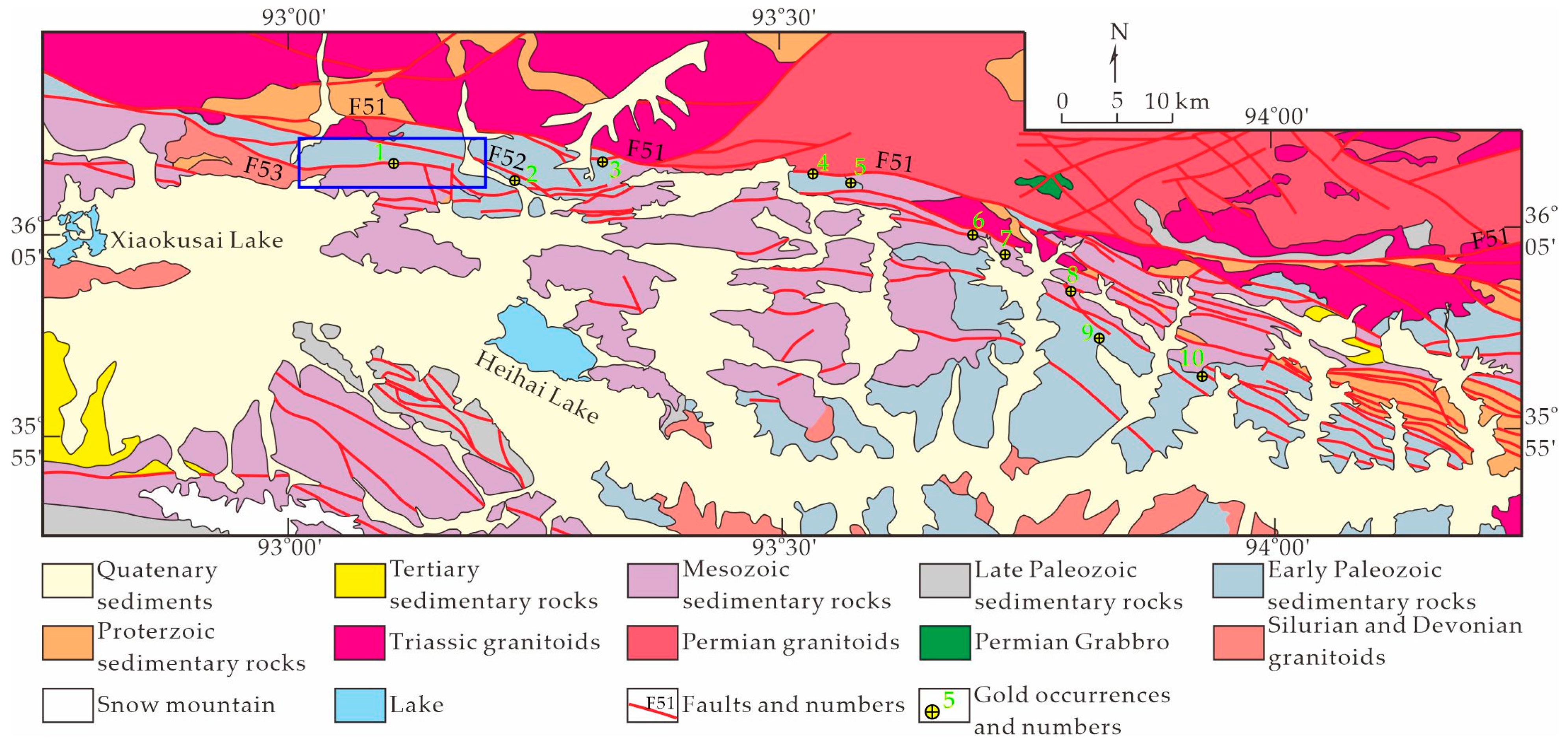
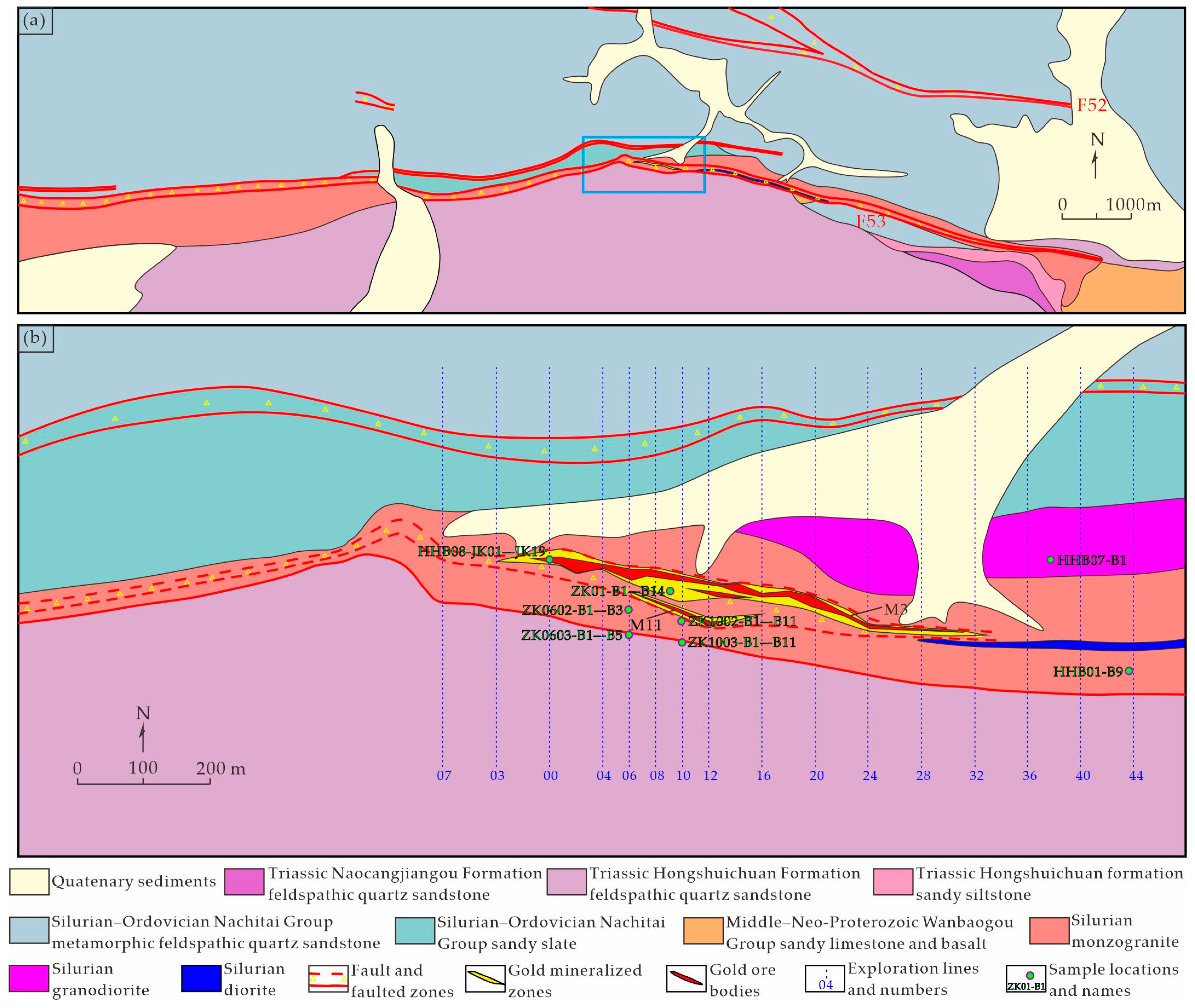

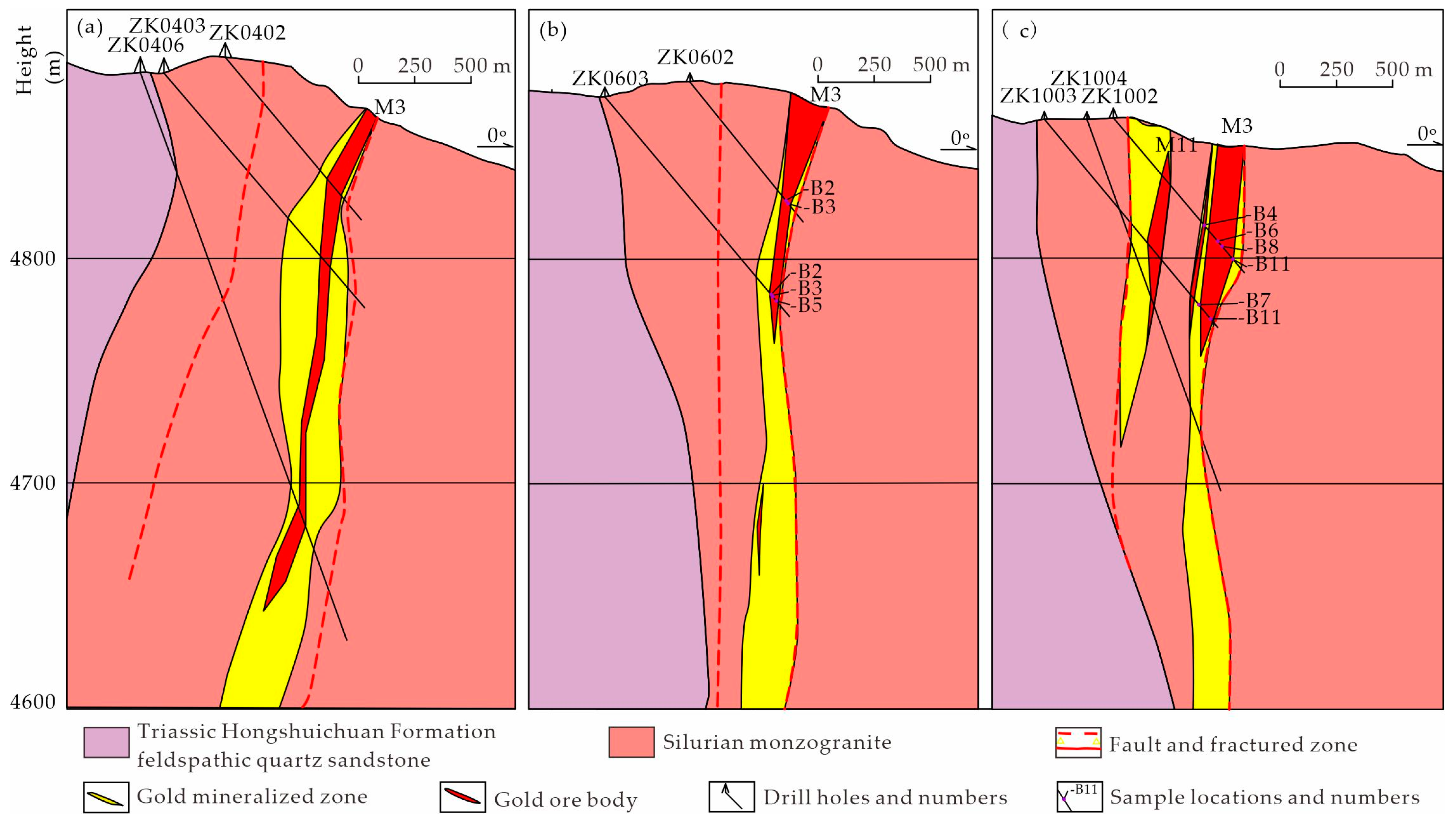

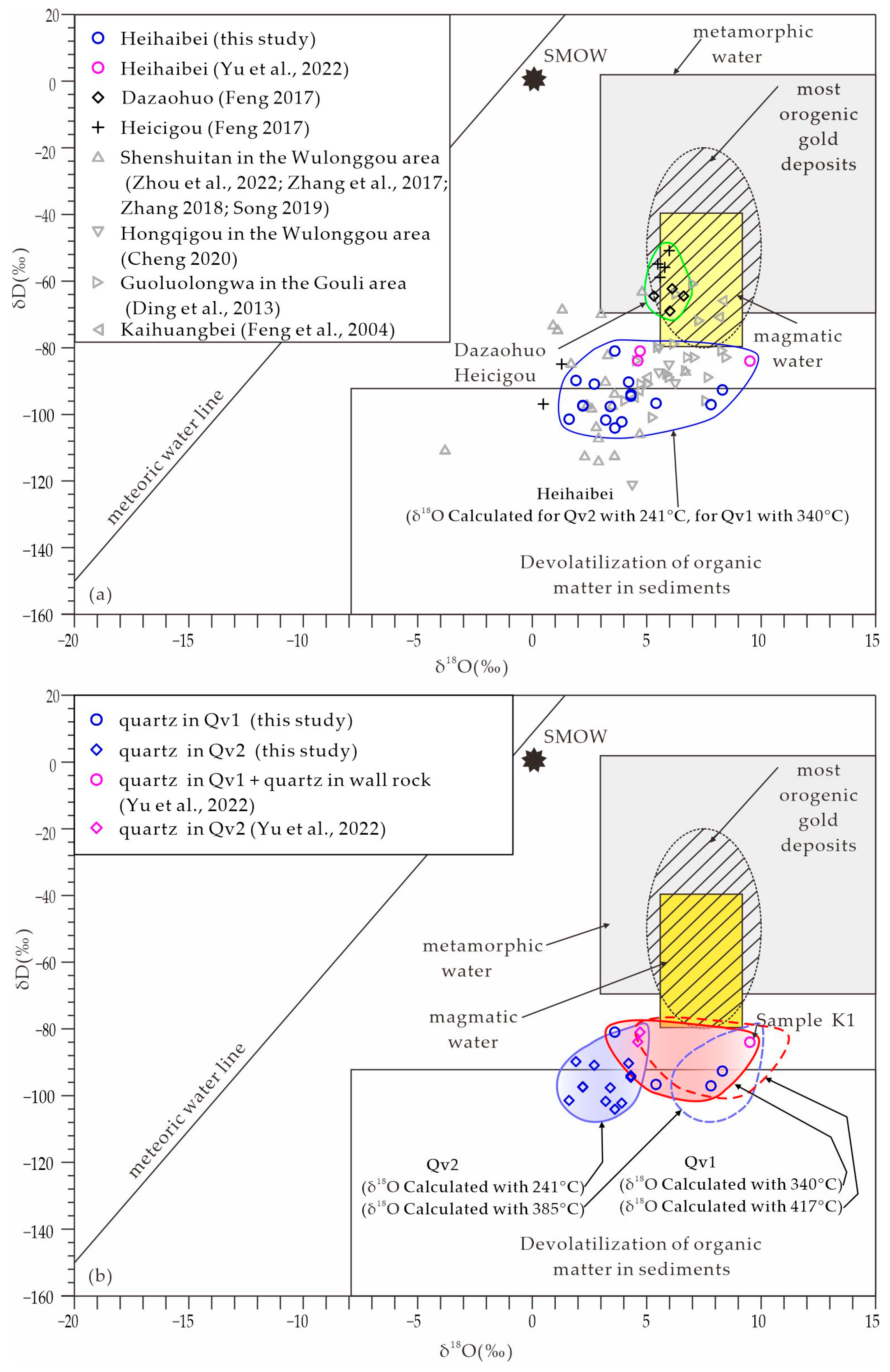

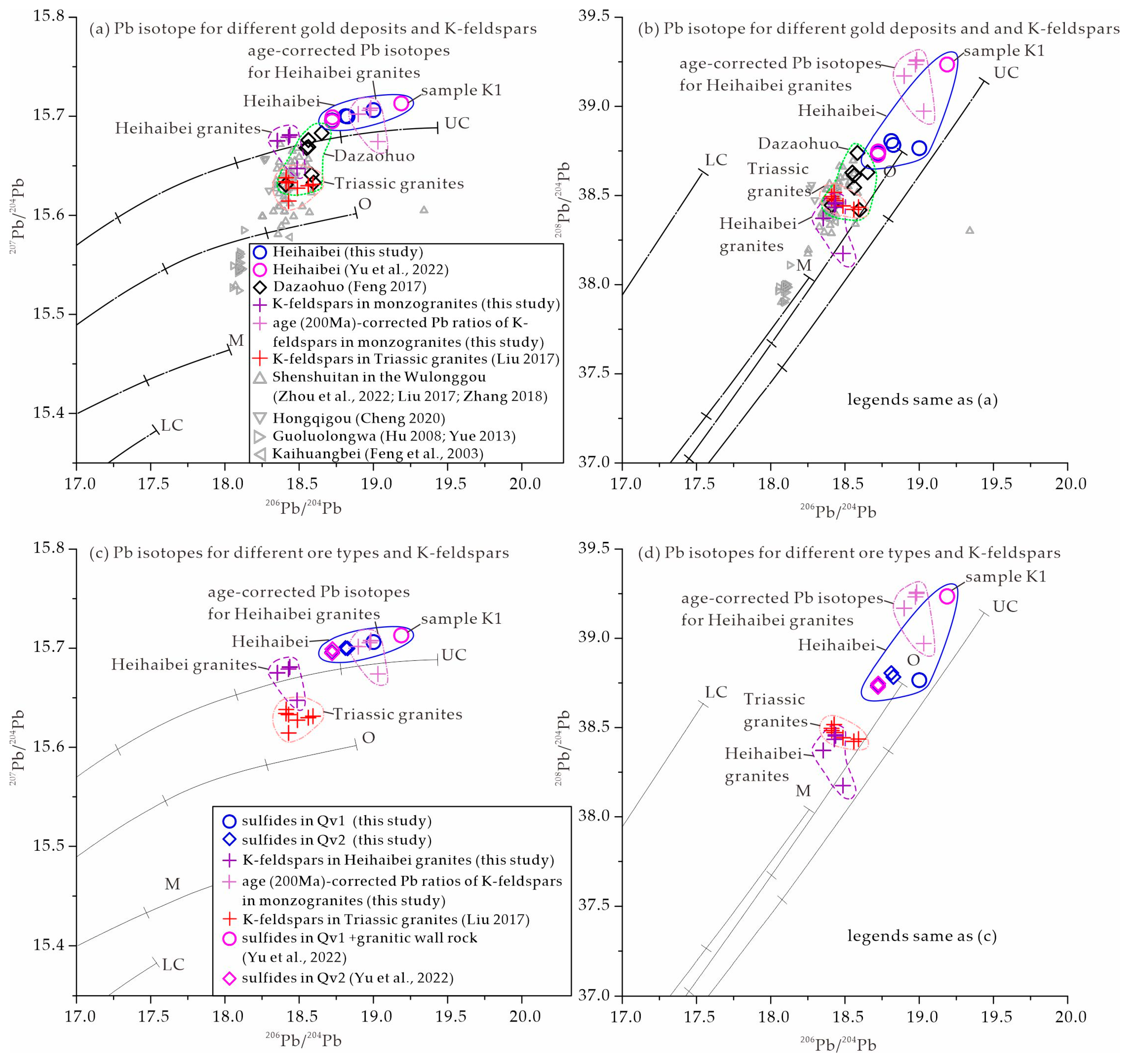
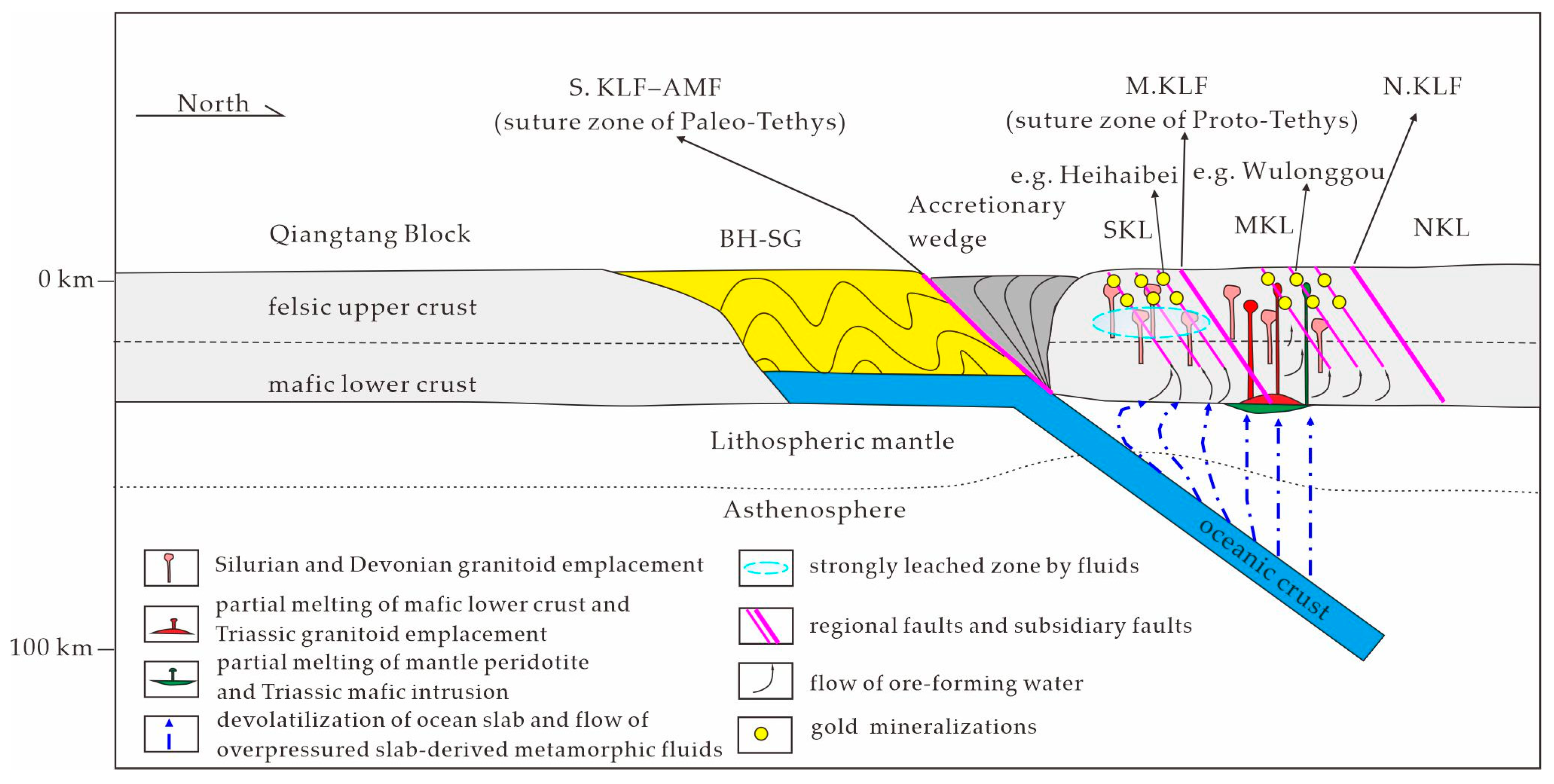
| No. | Sample Name | Rock Type | Ore Type | Mineral Assembly | Location |
|---|---|---|---|---|---|
| 1 | HHBZK0602-B2 | brecciated white quartz vein | Qv1 | quartz with minor sericite, pyrite, and arsenopyrite | 69.7 m of the drillhole core of the ZK1002 |
| 2 | HHBZK1002-B4 | brecciated white quartz vein | Qv1 | 62.9 m of the drillhole core of the ZK1004 | |
| 3 | HHBZK1002-B6 | brecciated white quartz vein | Qv1 | 72.3 m of the drillhole core of the ZK1004 | |
| 4 | HHBZK1002-B8 | brecciated white quartz vein | Qv1 | 75.5 m of the drillhole core of the ZK1004 | |
| 5 | HHB08-JK01 | white quartz vein | Qv1 | 93°06′39″ E, 36°08′35″ N | |
| 6 | HHB08-JK10 | white quartz vein | Qv1 | 93°06′39″ E, 36°08′35″ N | |
| 7 | HHB08-JK17 | white quartz vein | Qv1 | 93°06′39″ E, 36°08′35″ N | |
| 8 | HHBZK01-B3 | brecciated smoky grey quartz vein | Qv2 | quartz with some pyrite and arsenopyrite, and minor native gold, chalcopyrite, galena, and sphalerite, as well as tetrahedrite | 26.4 m of the drillhole core of the ZK01 |
| 9 | HHBZK01-B5 | brecciated smoky grey quartz vein | Qv2 | 29.6 m of the drillhole core of the ZK01 | |
| 10 | HHBZK01-B6 | brecciated smoky grey quartz vein | Qv2 | 30.3 m of the drillhole core of the ZK01 | |
| 11 | HHBZK0602-B3 | smoky grey quartz vein | Qv2 | 70.8 m of the drillhole core of the ZK0602 | |
| 12 | HHBZK0603-B2 | smoky grey quartz vein | Qv2 | 114.7 m of the drillhole core of the ZK0603 | |
| 13 | HHBZK0603-B3 | brecciated smoky grey quartz vein | Qv2 | 115.4 m of the drillhole core of the ZK0603 | |
| 14 | HHBZK0603-B5 | brecciated smoky grey quartz vein | Qv2 | 117.0 m of the drillhole core of the ZK0603 | |
| 15 | HHBZK1003-B11 | brecciated smoky grey quartz vein | Qv2 | 115.9 m of the drillhole core of the ZK1003 | |
| 16 | HHBZK1002-B11 | brecciated smoky grey quartz vein | Qv2 | 82.8 m of the drillhole core of the ZK1002 | |
| 17 | HHB08-JK02 | smoky grey quartz vein | Qv2 | 93°06′39″ E, 36°08′35″ N | |
| 18 | HHB08-JK03 | smoky grey quartz vein | Qv2 | 93°06′39″ E, 36°08′35″ N | |
| 19 | HHB08-JK05 | smoky grey quartz vein | Qv2 | 93°06′39″ E, 36°08′35″ N | |
| 20 | HHB08-JK08 | smoky grey quartz vein | Qv2 | 93°06′39″ E, 36°08′35″ N | |
| 21 | HHB08-JK13 | smoky grey quartz vein | Qv2 | 93°06′39″ E, 36°08′35″ N | |
| 22 | HHB08-JK15 | smoky grey quartz vein | Qv2 | 93°06′39″ E, 36°08′35″ N | |
| 23 | HHB08-JK18 | smoky grey quartz vein | Qv2 | 93°06′39″ E, 36°08′35″ N | |
| 24 | HHB08-JK19 | smoky grey quartz vein | Qv2 | 93°06′39″ E, 36°08′35″ N | |
| 25 | HHBZK01-B11 | monzogranite | wall rock | plagioclase, 25–40% alkali feldspar, 25–45% quartz, <5% biotite | 175.0 m of the drillhole core of the ZK01 |
| 26 | HHB01-B9 | monzogranite | wall rock | 93°07′14″ E, 36°08′30″ N | |
| 27 | HHBZK01-B14 | granodiorite | wall rock | 35–50% plagioclase, 35–45% quartz, 10–15% alkali feldspar, <5% biotite | 209.4 m of the drillhole core of the ZK01 |
| 28 | HHBZK1003-B7 | granodiorite | wall rock | 107.2 m of the drillhole core of the ZK1003 | |
| 29 | HHB07-B1 | granodiorite | wall rock | 93°07′09″ E, 36°08′36″ N |
| No. | Sample Name | Rock Type | Ore Type | Mineral | δDVSMOW (‰) | δ18OVSMOW (‰) | δ18OH2O (‰) | Average Th (°C) | References |
|---|---|---|---|---|---|---|---|---|---|
| 1 | HHBZK0602-B2 | brecciated white quartz vein | Qv1 | Quartz | −97.2 | 13.4 | 7.8 | 340.0 | this study |
| 2 | HHBZK0602-B3 | smoky grey quartz vein | Qv2 | Quartz | −91.0 | 12.1 | 2.7 | 241.0 | this study |
| 3 | HHBZK0603-B2 | smoky grey quartz vein | Qv2 | Quartz | −101.8 | 12.6 | 3.2 | 241.0 | this study |
| 4 | HHBZK0603-B3 | brecciated smoky grey quartz vein | Qv2 | Quartz | −97.7 | 12.8 | 3.4 | 241.0 | this study |
| 5 | HHBZK0603-B5 | brecciated smoky grey quartz vein | Qv2 | Quartz | −102.3 | 13.3 | 3.9 | 241.0 | this study |
| 6 | HHB08-JK01 | white quartz vein | Qv1 | Quartz | −81.1 | 9.2 | 3.6 | 340.0 | this study |
| 7 | HHB08-JK02-1 | smoky grey quartz vein | Qv2 | Quartz | −94.1 | 13.7 | 4.3 | 241.0 | this study |
| 8 | HHB08-JK02-2 | smoky grey quartz vein | Qv2 | Quartz | −94.6 | 13.7 | 4.3 | 241.0 | this study |
| 9 | HHB08-JK03 | smoky grey quartz vein | Qv2 | Quartz | −89.9 | 11.3 | 1.9 | 241.0 | this study |
| 10 | HHB08-JK05 | smoky grey quartz vein | Qv2 | Quartz | −90.4 | 13.6 | 4.2 | 241.0 | this study |
| 11 | HHB08-JK08 | smoky grey quartz vein | Qv2 | Quartz | −97.4 | 11.6 | 2.2 | 241.0 | this study |
| 12 | HHB08-JK10 | white quartz vein | Qv1 | Quartz | −92.8 | 13.9 | 8.3 | 340.0 | this study |
| 13 | HHB08-JK15 | smoky grey quartz vein | Qv2 | Quartz | −97.6 | 11.6 | 2.2 | 241.0 | this study |
| 14 | HHB08-JK17 | white quartz vein | Qv1 | Quartz | −96.8 | 11.0 | 5.4 | 340.0 | this study |
| 15 | HHB08-JK18 | smoky grey quartz vein | Qv2 | Quartz | −104.2 | 13.0 | 3.6 | 241.0 | this study |
| 16 | HHB08-JK19 | smoky grey quartz vein | Qv2 | Quartz | −101.5 | 11.0 | 1.6 | 241.0 | this study |
| 17 | K1 | silicified monzogranite | Qv1+wall rocks | Quartz | −84.1 | 15.1 | 9.5 | 340.0 | [23] |
| 18 | K5 | smoky grey quartz vein | Qv2 | Quartz | −81.1 | 14.1 | 4.7 | 241.0 | [23] |
| 19 | K7 | smoky grey quartz vein | Qv2 | Quartz | −84.0 | 14.0 | 4.6 | 241.0 | [23] |
| No. | Sample Name | Rock Type | Ore Type | Mineral | δ34SCDT(‰) | δ34SH2S(‰) | References |
|---|---|---|---|---|---|---|---|
| 1 | HHBZK01-B3 | brecciated smoky grey quartz vein | Qv2 | Pyrite | 8.5 | 7.0 | this study |
| 2 | HHBZK01-B5 | brecciated smoky grey quartz vein | Qv2 | Pyrite | 8.0 | 6.5 | this study |
| 3 | HHBZK01-B6 | brecciated smoky grey quartz vein | Qv2 | Pyrite | 7.7 | 6.2 | this study |
| 4 | HHBZK0603-B2 | smoky grey quartz vein | Qv2 | Pyrite | 8.0 | 6.5 | this study |
| 5 | HHBZK0603-B3 | brecciated smoky grey quartz vein | Qv2 | Pyrite | 7.6 | 6.1 | this study |
| 6 | HHBZK0603-B5 | brecciated smoky grey quartz vein | Qv2 | Pyrite | 8.0 | 6.5 | this study |
| 7 | HHBZK1003-B11 | brecciated smoky grey quartz vein | Qv2 | Pyrite | 7.6 | 6.1 | this study |
| 8 | HHBZK1002-B4-1 | brecciated white quartz vein | Qv1 | Pyrite | 8.1 | 7.0 | this study |
| 9 | HHBZK1002-B4-2 | brecciated white quartz vein | Qv1 | Pyrite | 8.0 | 6.9 | this study |
| 10 | HHBZK1002-B6 | brecciated white quartz vein | Qv1 | Pyrite | 8.0 | 6.9 | this study |
| 11 | HHBZK1002-B8 | brecciated white quartz vein | Qv1 | Pyrite | 8.1 | 7.0 | this study |
| 12 | HHBZK1002-B11 | brecciated smoky grey quartz vein | Qv2 | Pyrite | 7.8 | 6.3 | this study |
| 13 | HHB08-JK02 | smoky grey quartz vein | Qv2 | Pyrite | 8.5 | 7.0 | this study |
| 14 | HHB08-JK08 | smoky grey quartz vein | Qv2 | Pyrite | 8.0 | 6.5 | this study |
| 15 | HHB08-JK13 | smoky grey quartz vein | Qv2 | Pyrite | 8.3 | 6.8 | this study |
| 16 | HHB08-JK15 | smoky grey quartz vein | Qv2 | Pyrite | 8.2 | 6.7 | this study |
| 17 | HHB08-JK17 | white quartz vein | Qv1 | Pyrite | 8.7 | 7.6 | this study |
| 18 | K1 | silicified monzogranite | Qv1 + wall rocks | Arsenopyrite | 8.5 | [23] | |
| 19 | K5 | smoky grey quartz vein | Qv2 | Pyrite | 7.7 | [23] | |
| 20 | K8 | smoky grey quartz vein | Qv2 | Pyrite | 7.9 | [23] |
| No. | Sample | Rock Type | Ore Type | Mineral | 206Pb/204Pb | 207Pb/204Pb | 208Pb/204Pb | References |
|---|---|---|---|---|---|---|---|---|
| 1 | HHBZK01-B3 | brecciated smoky grey quartz vein | Qv2 | pyrite | 18.8122 | 15.7002 | 38.8055 | this study |
| 2 | HHBZK1002-B4 | brecciated white quartz vein | Qv1 | pyrite | 19.0007 | 15.7062 | 38.7655 | this study |
| 3 | HHB08-JK08 | smoky grey quartz vein | Qv2 | pyrite | 18.7219 | 15.6959 | 38.7356 | this study |
| 4 | HHB08-JK19 | smoky grey quartz vein | Qv2 | pyrite | 18.8262 | 15.6998 | 38.7836 | this study |
| 5 | HHBZK01-B11 | monzogranite | wall rock | K-feldspar | 18.4283 | 15.6789 | 38.4342 | this study |
| 6 | HHBZK01-B14 | granodiorite | wall rock | K-feldspar | 18.4363 | 15.6808 | 38.4532 | this study |
| 7 | HHBZK1003-B7 | granodiorite | wall rock | K-feldspar | 18.4864 | 15.6475 | 38.1750 | this study |
| 8 | HHB01-B9 | monzogranite | wall rock | K-feldspar | 18.4368 | 15.6812 | 38.4598 | this study |
| 9 | HHB07-B1-1 | granodiorite | wall rock | K-feldspar | 18.3532 | 15.6750 | 38.3713 | this study |
| 10 | HHB07-B1-2 | granodiorite | wall rock | K-feldspar | 18.3537 | 15.6753 | 38.3724 | this study |
| 11 | K1 | silicified monzogranite | Qv1 + wall rocks | pyrite | 19.188 | 15.713 | 39.235 | [23] |
| 12 | K5 | smoky grey quartz vein | Qv2 | pyrite | 18.722 | 15.695 | 38.728 | [23] |
| 13 | K12 | smoky grey quartz vein | Qv2 | pyrite | 18.724 | 15.699 | 38.746 | [23] |
Disclaimer/Publisher’s Note: The statements, opinions and data contained in all publications are solely those of the individual author(s) and contributor(s) and not of MDPI and/or the editor(s). MDPI and/or the editor(s) disclaim responsibility for any injury to people or property resulting from any ideas, methods, instructions or products referred to in the content. |
© 2023 by the authors. Licensee MDPI, Basel, Switzerland. This article is an open access article distributed under the terms and conditions of the Creative Commons Attribution (CC BY) license (https://creativecommons.org/licenses/by/4.0/).
Share and Cite
Lu, H.-F.; Pan, T.; Jiao, H.; Ding, Q.-F.; Zhou, X.; Wu, R.-Z. Isotope Geochemistry of the Heihaibei Gold Deposit within the Kunlun River Area in the Eastern Kunlun Orogen in Northwest China and Its Metallogenic Implications. Minerals 2023, 13, 274. https://doi.org/10.3390/min13020274
Lu H-F, Pan T, Jiao H, Ding Q-F, Zhou X, Wu R-Z. Isotope Geochemistry of the Heihaibei Gold Deposit within the Kunlun River Area in the Eastern Kunlun Orogen in Northwest China and Its Metallogenic Implications. Minerals. 2023; 13(2):274. https://doi.org/10.3390/min13020274
Chicago/Turabian StyleLu, Hai-Feng, Tong Pan, He Jiao, Qing-Feng Ding, Xuan Zhou, and Rui-Zhe Wu. 2023. "Isotope Geochemistry of the Heihaibei Gold Deposit within the Kunlun River Area in the Eastern Kunlun Orogen in Northwest China and Its Metallogenic Implications" Minerals 13, no. 2: 274. https://doi.org/10.3390/min13020274






